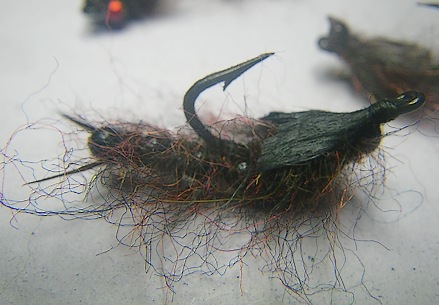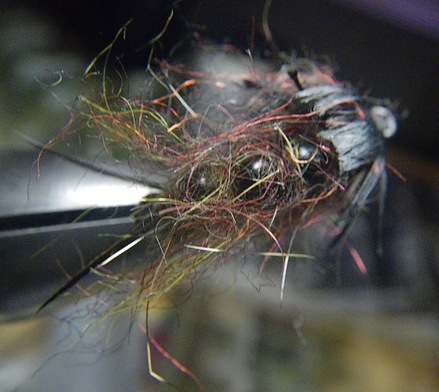At times I think an entirely separate blog is required to cover concepts of fly design, material handling, and methods of attachment. We’re often focused on visual imitation of the natural that we lose sight of the practical issues of swimming behavior and attitude in the water.
The only thing close to fiddling with someone else’s great idea and making it yours is cooking. You add additional tasty things hoping the sum of all parts is even better … and that’s not always the case.
To mitigate the fervor of inspiration and the wild frenzy it induces, I use three separate processes to adapt someone else’s idea to my fly box and style of fishing.
Combinations and Permutations: Fiddle with the idea alone, just to see what else it can do, and what else it would be good at …
Optimization: examine the rest of the fly to ensure other materials are matched with the new functionality, or assist its unique quality.
Swim Test: use the fly in a stream, lake, or bathtub, in the same manner it will be fished in the real world.
One or more of the phases will show a bad or impractical modification, a weakness in the materials chosen, or an attitude shift (caused by a material choice or attachment style) that cause the swimming fly to appear different than the natural or phase of the real insect you’re imitating.
In this case I’m still enamored of the bead-chained body from last week. and the feature being the massive weight of the body after attaching 4 – 6 brass beads.

Here’s an example of the Combination & Permutation phase, the full dubbed variant. I’ve merely topped the mess with a waxed nylon fiber wingcase as a placeholder for whatever I finally decide upon.
It certainly looks good if thrown with an eight weight. I’ve inserted dubbing between every joint in the chain, which extends all the way to the eye (7 full beads). The body remains flexible but is no longer droopy, and the nylon fibers are indestructible so the wingcase choice is actually an Optimization decision.
Seven brass beads mounted on the top of the fly will cause the fly to ride upside down, so the wingcase is mounted underneath the hook as a Swim decision. All that weight means it’ll be hitting every rock, every sunken tree limb and incur a great deal of damage. The nylon wingcase is impervious to impact, so it’s mounted for Swim, with material chosen per an Optimize quality.
Were you to mount the traditional slip of oak turkey as a wingcase, it would probably last about four casts before being broken to pieces. Which might be just fine – as you’ll probably leave this in a sunken tree limb every second cast …

Here’s the same fly tied in the Czech Nymph style. Beads follow the curvature of the hook and are secured at each joint. I’ve used the same black nylon fiber for the wingcase – but this time it’s distributed all the way around the fly – and the fly’s attitude in the water is now moot.
All Czech nymphs ride upside down, their attitude being a combination of shape of the hook and placement of the lead wire underbody. Its a mystery to me why they aren’t tied upside down, that waxy and grub-like shellback points at the river bottom and not where the fish can spy it.
In extending the “wingcase” material completely around the hook means I’ve eliminated the top and bottom of the fly, and the fly looks identical from every angle.
All the same rationale explained above applies here. Material choices made for banging on rocks and surviving, fly tied to swim as the real bug might – if it were curled to protect its nuts while tumbling downstream.
I suspect that the steelhead version will retain the brass bead chain, but the trout flavor will be moved to aluminum anodized beads. The properties of bead chain are identical, only the weight will differ – and the aluminum will allow the bug to be cast versus lobbed – and fished only on the short line.

I like how it looks with the chain dubbed!
Sweet fly!
Very nice rough and multi-coloured dubbing you’ve got there, Keith! Somehow the fly reminds me of Bill Blackstone’s black stone. Which is weird, as that’s a TOTALLY different tie.
These flies are very well tied and it would be a crying shame to have them stuck in a tree root as opposed to a trout. Dubbing looks more authentic when it is mixed in this way. Super flies.
Excellent variation, Keith. I’ve been playing with the stuff you send last week, gonna put it to the test pretty soon.
Awesome!
Please keep this up… so that once you’ve refined the beadchain patterns through trial and error I can steal your hard work for my box.
A Singlebarbed fly tying blog would be nice too, but we might miss your excellent posts on the esoteric and generally odd things you write so well about.
You should have a (chain) of booths in Macy’s or Nordstrom’s men’s departments. Fishers could bring their flies to you for evaluation and a potential “make over”. But no, that would be to Fly Guy Elitist, Nah…
Damn nice ties. “If you aren’t loosing flies, you aren’t nymphing!”
@John – It would be elitist only if I used any of the words, garish, clash, so-yesterday, or skin tone.
@Don – I’m not sure excellent is appropriate, I’d settle for “clownish and infantile” however.
Point taken. See ya at the Mall!